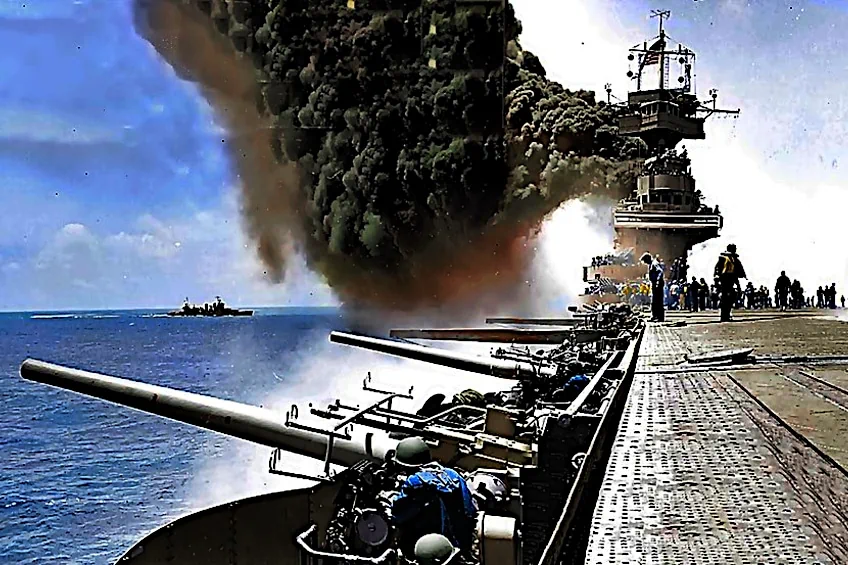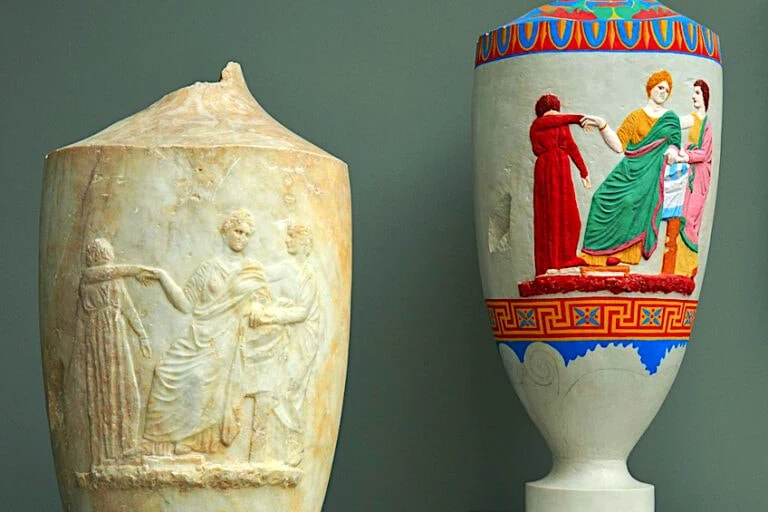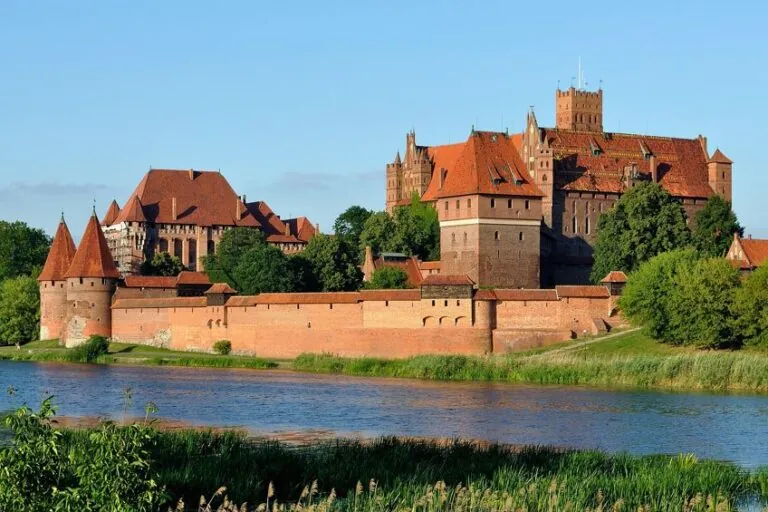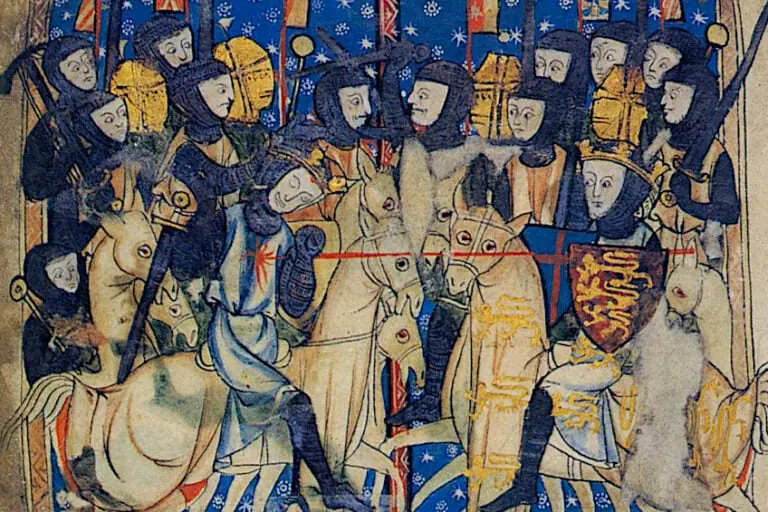Famous Battles – History’s Major Military Engagements
While we may like to believe that open communication can solve most conflicts in life, in reality, humans have often had to resort to warfare to settle disputes over territories, ideologies, natural resources, religious views, and countless other issues. The most important battles ever fought resulted in huge shifts in the way we subsequently lived our lives. But, what are the most famous battles and what is the biggest battle in history? Let’s find out more about these crucial moments in our history, and how they influenced and shaped the world.
Contents
The Most Famous Battles of Human History
Whenever wars have been fought, they have often lasted for several years, sometimes decades. War is not one continuous barrage, though, but rather a series of carefully orchestrated battles that are carried out in order to further advance the positions of an army into any given region and thereby claim and expand territories.
We can observe this exact scenario currently playing out in Ukraine, where a war that was expected to last a few weeks escalated into a years-long conflict with no end in sight.
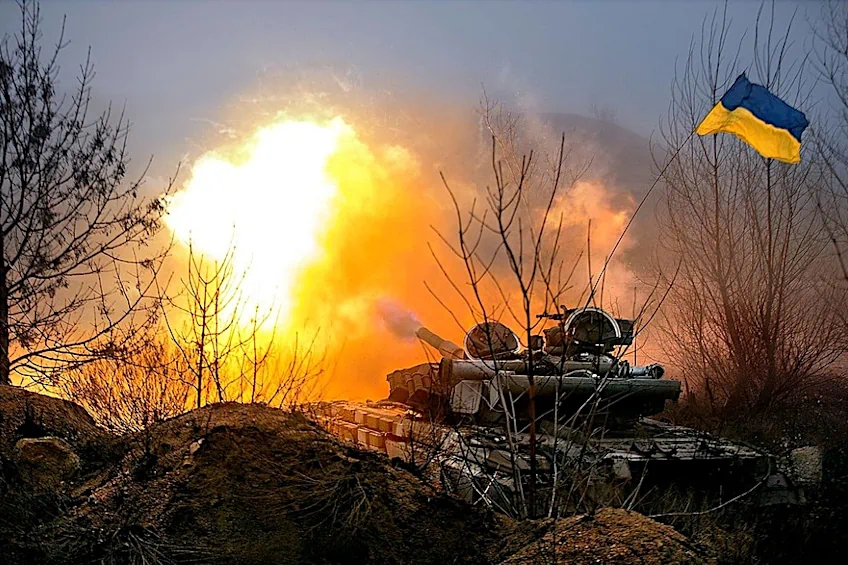 Photograph of a Ukrainian military armored vehicle in a conflict zone; Ministry of Defense of Ukraine, CC BY-SA 2.0, via Wikimedia Commons
Photograph of a Ukrainian military armored vehicle in a conflict zone; Ministry of Defense of Ukraine, CC BY-SA 2.0, via Wikimedia Commons
We can also observe how territories are seized or reclaimed as certain battles play out in regions on a frontline that is ever-shifting across the terrain. Let’s find out what the largest battle in history was, what the most important battles were, and their long-term impact on society in general.
Ancient Battles
Territorial expansion, fortune, power, vengeance, and self-protection were all motives for ancient warfare. In numerous instances, people waged battles to gain ownership of vital trading routes, land for agriculture, and mineral deposits. Battles had a huge effect on politics, culture, and society in general throughout the ancient world.
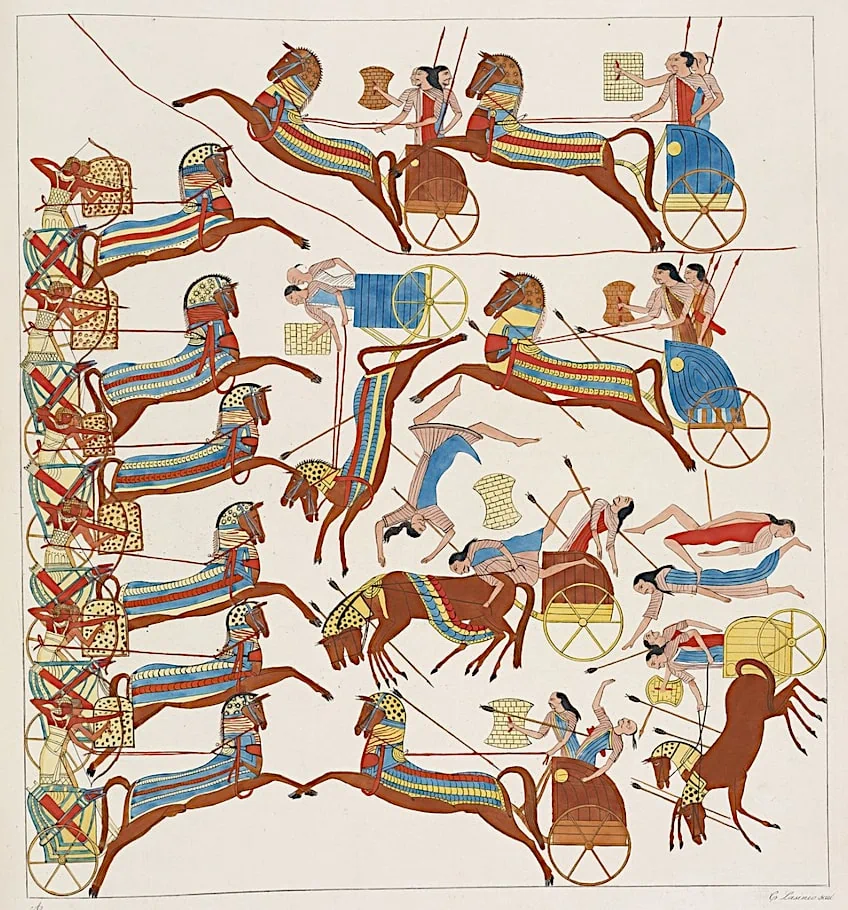 Archaeologist’s drawing of the depiction of a chariot battle on the walls of Abu Simbel temple commemorating the military campaigns o Rameses II (1832); Scan by NYPL, Public domain, via Wikimedia Commons
Archaeologist’s drawing of the depiction of a chariot battle on the walls of Abu Simbel temple commemorating the military campaigns o Rameses II (1832); Scan by NYPL, Public domain, via Wikimedia Commons
Victories were regarded as proof of divine favor, and they often culminated in the territorial expansion of empires and power consolidation.
Defeat in battle, though, could result in the fall of mighty empires, the replacement of monarchs, and the development of new political power structures.
Battle of Marathon (490 BCE) in Marathon, Greece
| Battle Name | Battle of Marathon |
| Date | 490 BCE |
| Combatants | Athenians and Persians |
| Location | Marathon, Greece |
During the first Greco-Persian War in 490 BCE, the Battle of Marathon was fought between a largely Athenian Greek army and a Persian army. The Persian soldiers were decisively beaten on the shore of Marathon, around 40 kilometers from Athens. Greece was not a unified nation at the time, but rather a group of separate city-states. By defeating the Persians, they contributed to Greece’s sustained independence from Persian domination.
The Athenians were renowned for using fast runners to carry messages. The origins of the marathon race can be traced back to one of these runners who carried the request for assistance from Athens to Sparta in a day.
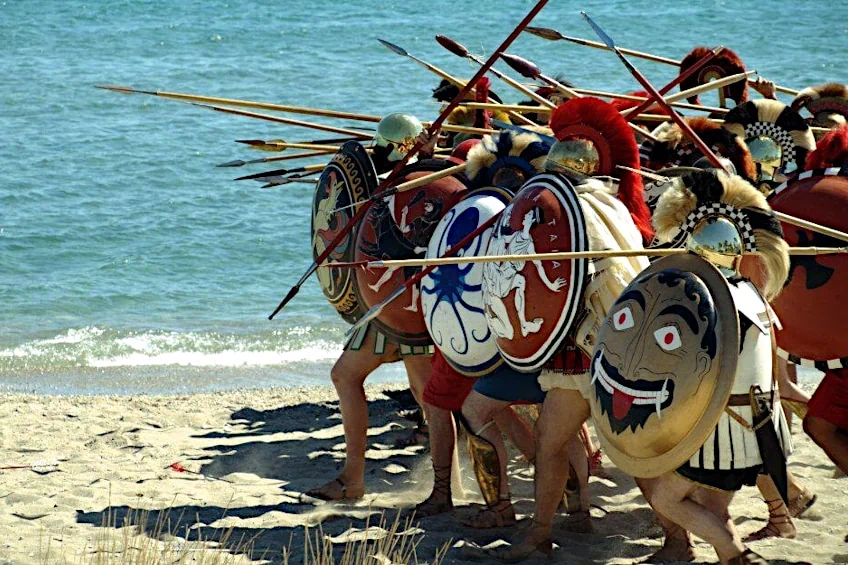 Greek hoplites charging during a modern re-enactment of the Battle of Marathon (2011); Phokion, CC BY-SA 4.0, via Wikimedia Commons
Greek hoplites charging during a modern re-enactment of the Battle of Marathon (2011); Phokion, CC BY-SA 4.0, via Wikimedia Commons
The full story of what happened at the Battle of Marathon will never be known. The majority of what we know comes from Herodotus, the ancient historian from Greece, who wrote about the battle decades after it actually happened. The Persians’ defeat at the Battle of Marathon effectively ended the Persian Empire’s further expansion into the West and ensured Greek independence. This enabled Greek concepts to thrive and propagate, having a significant impact on the Western world up to today.
Battle of Thermopylae (480 BCE) in Thermopylae, Greece
| Battle Name | Battle of Thermopylae |
| Date | 480 BCE |
| Combatants | Greeks and Persians |
| Location | Thermopylae, Greece |
The Persian Empire, led by King Xerxes I, wanted to invade Greece with the intention of seizing the city-states. These Greek city-states banded together, and King Leonidas I of Sparta was assigned with leading the defense against the Persian invaders. King Leonidas and his very small group of 300 Spartan warriors, in addition to soldiers from other Greek city-states, carried out an attack at Thermopylae, a narrow pass through which the Persian army had to pass in order to march deeper into Greece.
The Greeks held off the considerably larger Persian force for three days, exacting considerable losses on the Persian army and dealing a major setback to Xerxes.
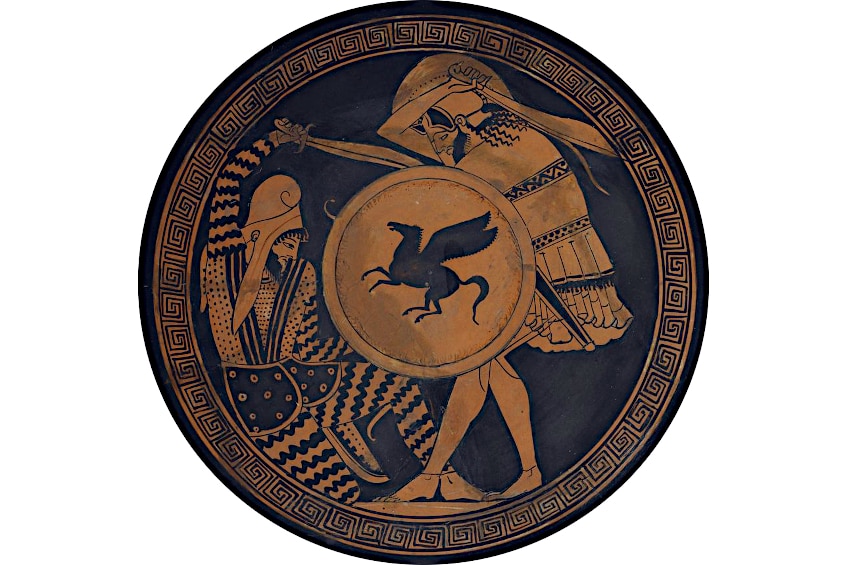 Kylix decorated with a depiction of a Persian warrior and a Greek Hoplite engaged in combat (5th Century BCE); Ελληνικά: ΆγνωστοςFrançais : Coupe attribuée au Peintre de Triptolème., Public domain, via Wikimedia Commons
Kylix decorated with a depiction of a Persian warrior and a Greek Hoplite engaged in combat (5th Century BCE); Ελληνικά: ΆγνωστοςFrançais : Coupe attribuée au Peintre de Triptolème., Public domain, via Wikimedia Commons
A local citizen, however, ended up betraying the Greeks by revealing a mountain trail that would enable the Persians to outflank them. King Leonidas and his warriors battled valiantly until they were cornered and eventually slaughtered. Despite being defeated, the Greeks were able to stall the Persian’s advance and give the rest of Greece time to get prepared for the oncoming Persian invasion.
This delay enabled the Greeks to defeat the Persians decisively the following year.
Battle of Gaugamela (331 BCE) in Gaugamela, Mosul
| Battle Name | Battle of Gaugamela |
| Date | 331 BCE |
| Combatants | Macedonian and Persian armies |
| Location | Gaugamela, Erbil, Mosul |
For several years, the Persian Empire had been at odds with Alexander the Great’s Macedonian army. The two armies finally encountered each other at Gaugamela, where Darius III had collected a massive army to protect his territory, including chariots and war elephants. Alexander the Great commanded his army of roughly 40,000 men, comprising cavalry and phalanx infantry, into battle against a significantly greater Persian army, which was thought to have numbered up to 100,000 men.
 The Battle of Issus formerly known as The Battle of Gaugamela by Jan Brueghel the Elder (1602); Jan Brueghel the Elder, Public domain, via Wikimedia Commons
The Battle of Issus formerly known as The Battle of Gaugamela by Jan Brueghel the Elder (1602); Jan Brueghel the Elder, Public domain, via Wikimedia Commons
Despite immense odds, Alexander’s army triumphed. His inventive tactics, such as forming a wedge formation to penetrate through Persian lines and using cavalry to assault the Persian army’s flanks, were successful.
The Macedonian victory at Gaugamela marked a historic milestone in Alexander’s conquest of the Persians, allowing him to seize crucial cities like Susa, Babylon, and Persepolis. The fight was particularly significant culturally and politically, as it signified the crumbling of the Achaemenid Persian Empire and the start of the period known as the Hellenistic era.
Battle of Cannae (216 BCE) in Cannae, Italy
| Battle Name | Battle of Cannae |
| Date | 216 BCE |
| Combatants | Romans and Carthaginians |
| Location | Cannae, Italy |
The Battle of Cannae was a significant historical battle between the Carthaginian Empire and the Roman Empire. Hannibal, the general who traversed the Alps with his troops to attack Italy, headed the Carthaginian forces. The Republic of Rome had been in conflict with Carthage for a long time leading up to the battle. The Roman army was headed by consuls Gaius Terentius Varro and Lucius Aemilius Paullus.
Hannibal, despite being heavily outnumbered, was able to outmaneuver the Roman soldiers thanks to his superior tactical talents. He arranged his men in the pattern of a crescent, with his cavalry on the ends and infantry in the middle.
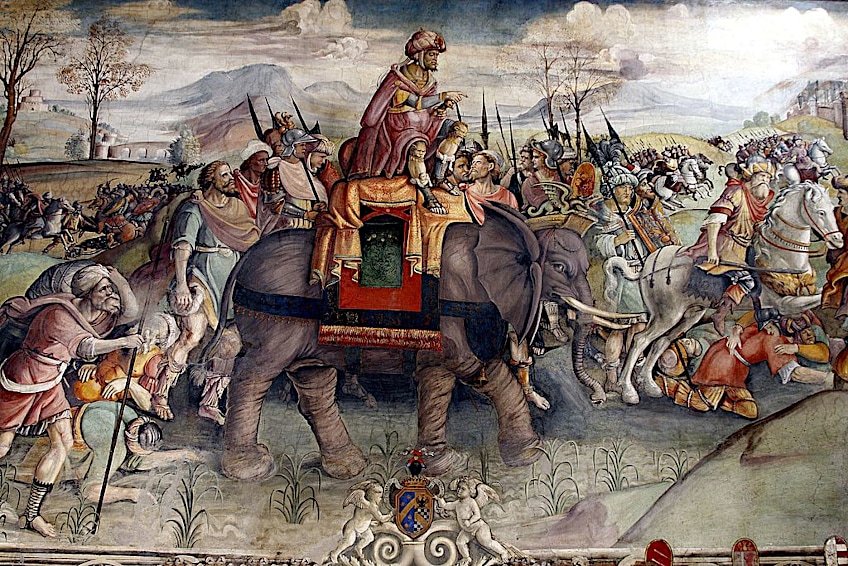 Hannibal in Italy by Jacopo Ripanda (1505-1506); © José Luiz Bernardes Ribeiro
Hannibal in Italy by Jacopo Ripanda (1505-1506); © José Luiz Bernardes Ribeiro
The Romans charged at the heart of the Carthaginian forces, but Hannibal’s troops withdrew, trapping the Romans. After that, the Carthaginian cavalry charged the Roman flanks, enveloping, and overwhelming the Romans. It was regarded as one of the most significant military victories in ancient history, and it has often been referred to as an outstanding instance of strategic genius. The war had far-reaching implications for the Roman Republic, leaving Rome exposed to additional Carthaginian incursions and causing a substantial loss of confidence among the Roman population.
Medieval Battles
Medieval battles were waged for a multitude of reasons, such as territorial and resource acquisition, rivalries for power between empires and kingdoms, religious tensions, and disagreements over ideologies. Battles were also waged to protect or expand the frontiers of an empire or kingdom, to preserve trade routes, or to control strategically important locations such as castles or fortifications.
Battles were vital in establishing and retaining power in the medieval period, as they often defined who would reign over a certain territory or country.
Battle of Hastings (1066) in Hastings, United Kingdom
| Battle Name | Battle of Hastings |
| Date | 1066 |
| Combatants | Norman-French and English |
| Location | Hastings, East Sussex, United Kingdom |
The Battle of Hastings was fought between the newly enthroned Harold Godwineson and William, Duke of Normandy over the crown of England. On the morning of the 14th of October, 1066, the British army took up their position on Senlac Hill nearby Hastings. After the difficult, violent fight to conquer Stamford Bridge in Yorkshire a few days earlier, Harold’s fatigued and diminished Saxon men were obliged to march southwards. William attacked with both infantry and cavalry; in true English fashion, Harold’s well-trained warriors battled on foot behind their massive shield wall. The battle went on for the majority of the day, with the shield wall remaining intact.
It is reported that the view of retreating Normans drew the English away from their positions of defense, causing them to break ranks to pursue the enemy. The English were susceptible to a cavalry attack once their well-planned formation was shattered.
 Detail from the Bayeux Tapestry showing fallen horses and knights at the Battle of Hastings (11th Century); Bayeux Tapestry designer and seamstresses, Public domain, via Wikimedia Commons
Detail from the Bayeux Tapestry showing fallen horses and knights at the Battle of Hastings (11th Century); Bayeux Tapestry designer and seamstresses, Public domain, via Wikimedia Commons
King Harold was killed when a stray Norman arrow wounded him in the eye, but the combat continued until all of Harold’s devoted bodyguards were slaughtered. This conflict altered the trajectory of not only British but also European history. England would be dominated by an oppressive foreign nobility from now on, influencing all political and religious institutions in Christendom.
Battle of Crécy (1346) in Crécy-en-Ponthieu, France
| Battle Name | Battle of Crécy |
| Date | 1346 |
| Combatants | French and English |
| Location | Crécy-en-Ponthieu, Calais, France |
King Edward III’s English army had invaded France and was being chased by King Philip VI’s much bigger French army. Despite being heavily outnumbered, the English army, which was mostly made up of dismounted knights and longbowmen, was well-organized and prepared for the fight. They took up a defensive vantage point on a hill, with woodland on one side to defend their flank. The French army, though, was primarily made up of cavalry and armored knights that pushed recklessly into the English lines.
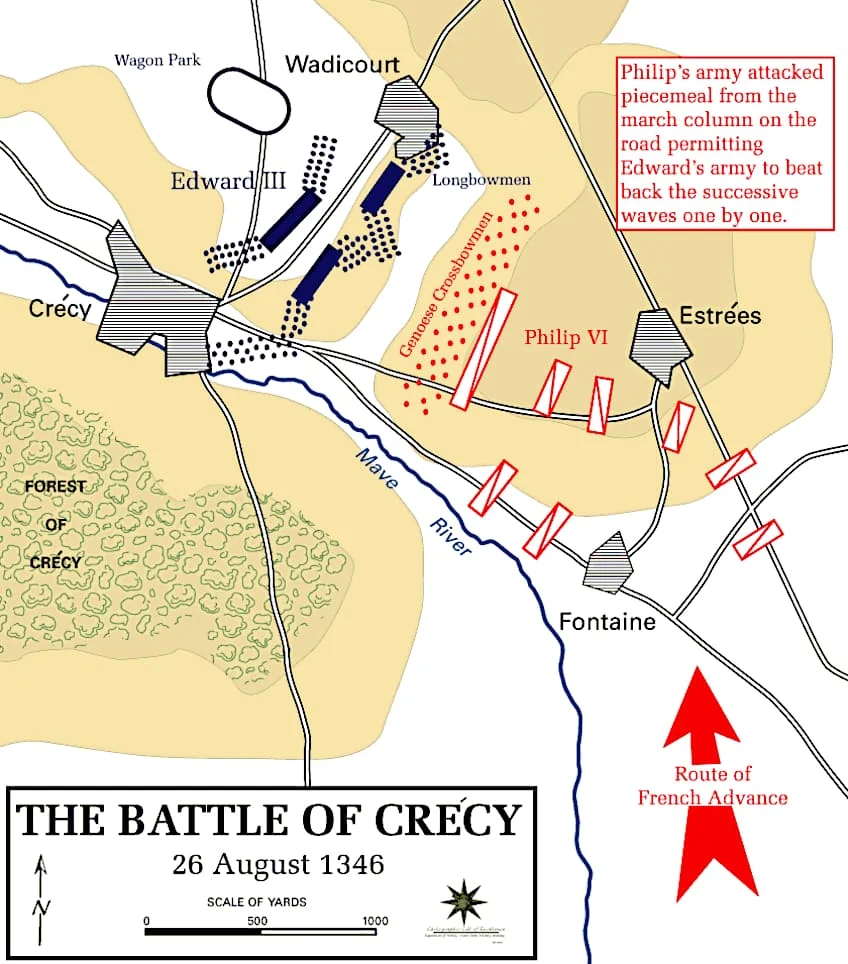 Map showing tactics at the Battle of Crécy; https://westpoint.edu/sites/default/files/inline-images/academics/academic_departments/history/Modern%20Warfare/battle_crecy.gif, Public domain, via Wikimedia Commons
Map showing tactics at the Battle of Crécy; https://westpoint.edu/sites/default/files/inline-images/academics/academic_departments/history/Modern%20Warfare/battle_crecy.gif, Public domain, via Wikimedia Commons
The English longbowmen used their advantage in range and precision to pour down a deadly storm of arrows on the French, who suffered substantial casualties.
The French onslaught was halted, and the English knights launched a counter-attack, storming downhill into the disoriented French army. The Battle of Crécy was an important triumph for the English, and it had far-reaching consequences for the Hundred Years’ War, which lasted until 1453. The British victory at Crécy established the longbow’s efficiency against the heavy horse attacks that characterized medieval warfare, paving the stage for additional English successes at battles like Agincourt.
Battle of Poitiers (1356) in Poitiers, Maupertuis
| Battle Name | Battle of Poitiers |
| Date | 1356 |
| Combatants | French and Anglo-Gascon |
| Location | Poiters, Nouaillé-Maupertuis, Maupertuis |
The Battle of Poitiers was a disastrous defeat suffered by King John II of France at the completion of the first phase of the Hundred Years’ War between England and France. Many members of the French nobility were assassinated, and King Jean was imprisoned by the English.
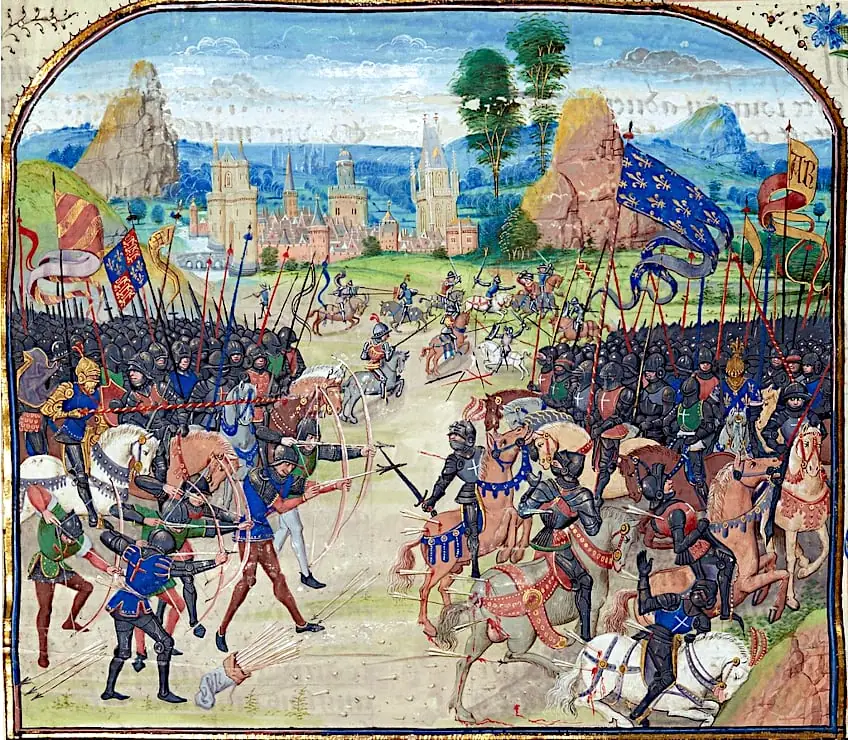 The Battle of Poitiers by Loyset Liédet (c. 1470-1480); Loyset Liédet, Public domain, via Wikimedia Commons
The Battle of Poitiers by Loyset Liédet (c. 1470-1480); Loyset Liédet, Public domain, via Wikimedia Commons
Forced into a combat he didn’t want, Edward chose his position deliberately, a slope sheltered on the left by a stream and marsh, and a hedge in front with only one opening through which four knights could ride side by side. Except for a small reserve army on his right flank, Edward drew up his bowmen behind the hedge and dismounted all of his horsemen. The first French cavalry rode toward the English and tried to storm through the hedge’s gap. As they approached the opening, the British bowmen opened fire, sending the knights down from their horses, only to be killed in hand-to-hand combat.
The fighting was fierce, with many British bowmen battling with knives due to a lack of arrows. The French king and his royal guard were eventually overcome.
Battle of Agincourt (1415) in Azincourt, France
| Battle Name | Battle of Agincourt |
| Date | 1415 |
| Combatants | English and French |
| Location | Azincourt, France |
King Henry V led an 11,000-strong force to Normandy from Southampton in August 1415, with the intention of reclaiming lost land and staking an English claim to the French crown. The assault required a large number of soldiers and weapons, as well as an armada of 100s of ships, none of which were inexpensive. King Henry was able to persuade Parliament to collect more taxes and loan vast sums from wealthy English residents and cities to fund his mission. On the morning of the 25th of October, the French and English forces clashed at Agincourt.
Fearing a further French invasion, King Henry infamously ordered the execution of the French prisoners in the early afternoon. The English suffered very few casualties, but the Battle of Agincourt was not a completely resounding success for them.
The French sustained severe losses in terms of lives lost and prisoners taken, but these were not sufficiently significant to persuade them to negotiate. However, King Henry’s success made his later acquisition of Normandy easier because the French army was hesitant to fight him again.
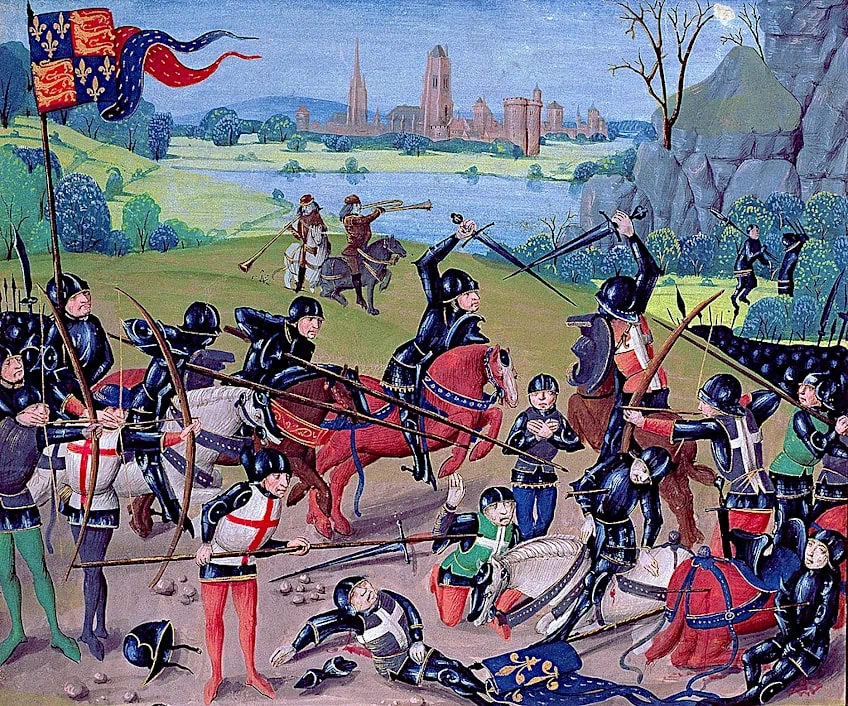 The Battle of Agincourt by an unknown artist (c. 1422); Unknown – Ms 6 f.243 Battle of Agincourt, 1415, English with Flemish illuminations, from the ‘St. Alban’s Chronicle’ by Thomas Walsingham (vellum), English School, (15th century), Public domain, via Wikimedia Commons
The Battle of Agincourt by an unknown artist (c. 1422); Unknown – Ms 6 f.243 Battle of Agincourt, 1415, English with Flemish illuminations, from the ‘St. Alban’s Chronicle’ by Thomas Walsingham (vellum), English School, (15th century), Public domain, via Wikimedia Commons
Early Modern Era Battles
With the introduction of gunpowder weaponry and the rising emphasis on organized infantry over cavalry attacks, this period saw substantial advancements in military technology and strategies. Battles were critical in establishing and upholding power structures among European nations engaged in periodic disputes over resources and territory during the Early Modern Era.
The development of powerful nation-states influenced many of these battles, as kings strove to enhance their influence and dominance over their neighboring territories. Religious conflicts were also prominent in the Early Modern Era, especially religious warfare in Europe between Protestants and Catholics.
Battle of Lepanto (1571) in Gulf of Patras, Ionian Sea
| Battle Name | Battle of Lepanto |
| Date | 1571 |
| Combatants | Holy League and Ottoman Empire |
| Location | Gulf of Patras, Ionian Sea |
The Battle of Lepanto was a maritime battle that occurred in the Gulf of Patras in the Ionian Sea on the 7th of October, 1571, between the Holy League and the Ottoman Empire, a coalition of European kingdoms. Pope Pius V established the Holy League to oppose the threat that the Ottomans posed in the Mediterranean and to preserve Christian Europe from attack. The conflict started with a clash of the two fleets, with the forces of the Ottoman Empire appearing to take the upper hand at first.
 Disposition of the Venetian and Ottoman fleets during the Battle of Lepanto in 1571 by Camocio Giovanni Francesco (1574); Giovanni Francesco Camocio, Public domain, via Wikimedia Commons
Disposition of the Venetian and Ottoman fleets during the Battle of Lepanto in 1571 by Camocio Giovanni Francesco (1574); Giovanni Francesco Camocio, Public domain, via Wikimedia Commons
The Holy League was able to regroup and execute a counterattack, and the battle was eventually won by them, with the Ottomans suffering severe casualties. The victory at Lepanto was vital for the Holy League because it stopped the Ottomans from acquiring control of the Mediterranean region.
The Battle of Lepanto is especially notable in military history since it was one of the biggest naval conflicts in history at the time, as well as the final major confrontation between galleys as a principal naval weapon.
Battle of Blenheim (1704) in Blindheim, Germany
| Battle Name | Battle of Blenheim |
| Date | 1704 |
| Combatants | Franco-Bavarian and British, Austrian and Dutch allied force |
| Location | Blindheim, Germany |
The Battle of Blenheim, which took place on the 13th of August, 1704, was an important turning point in the Spanish Succession War, protecting Vienna from the Franco-Bavarians and stopping the Grand Alliance from collapsing.
To wrap up the war quickly, Louis XIV of France intended to take over Emperor Leopold’s capital and then force Austria out.
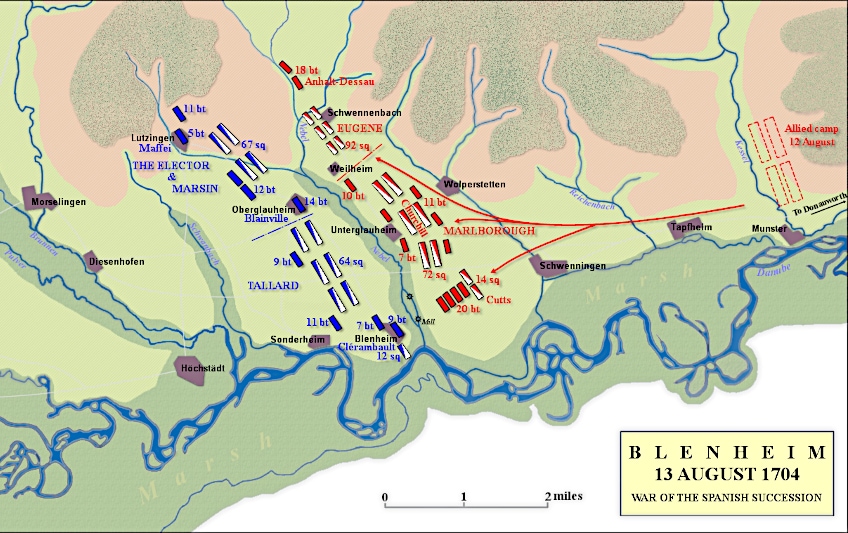 Map of the Battle of Blenheim, 13 August 1704; Rebel Redcoat, CC BY-SA 3.0, via Wikimedia Commons
Map of the Battle of Blenheim, 13 August 1704; Rebel Redcoat, CC BY-SA 3.0, via Wikimedia Commons
The forces of France and its Bavarian allies, as well as an uprising in Austrian-controlled Hungary, served as a potential threat to Vienna from all sides. Recognizing the risk, the Duke of Marlborough advanced his men the 400 kilometers to the Danube River from the Low Countries in just five weeks, masterfully concealing his location from both friends and enemies. At Blenheim, Prince Eugene of Savoy and Marlborough defeated the Franco-Bavarian army with an overwhelming victory.
With Bavaria now out of the war, Louis’s prospects for a swift victory were crushed. France sustained about 30,000 casualties, most notably the commander-in-chief, Marshal Tallard, who was captured and brought to England. The Alliance had conquered Trier, Landau, and Trarbach by the end of that year and was set to take the battle into France proper.
Battle of Trafalgar (1805) in Strait of Gibraltar, Spain
| Battle Name | Battle of Trafalgar |
| Date | 1805 |
| Combatants | English, Spanish, and French armies |
| Location | Strait of Gibraltar, Spain |
As part of Napoleon’s preparations for attacking England, the Spanish and French fleets joined forces to seize control of the English Channel and assure safe passage for the Grande Armée. On the 18th of October 1805, the combined fleet embarked from the port of Cadiz in southern Spain. They came across Lord Nelson’s British fleet off the southwest coast of Spain, near Cape Trafalgar, which had recently been formed to confront this potential threat.
Nelson was quite substantially outnumbered, so he maneuvered his fleet straight at the flank of the French-Spanish line in the hopes of breaking it up. The French had been concerned that Nelson may try this technique, but had made no preparations for it for many different reasons.
Nelson’s divisions split the Franco-Spanish fleet in three. The allied French-Spanish fleet sailed off while attempting to turn back, providing the British a temporary advantage over the rest of their fleet. The ensuing furious action resulted in the loss of 22 allied ships while the English did not lose a single vessel.
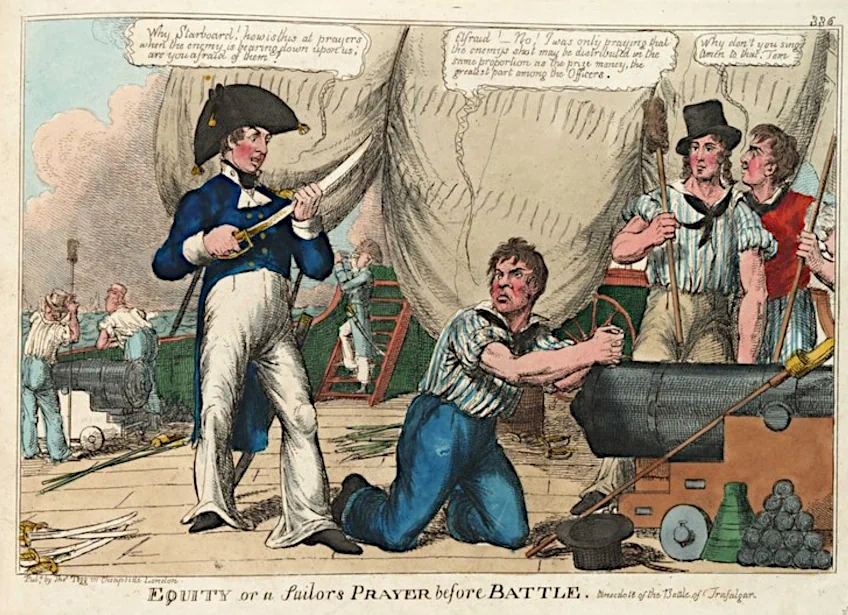 Equity or a Sailor’s Prayer before Battle. Anecdote of the Battle of Trafalgar by Thomas Tegg (c. 1805); Thomas Tegg, Public domain, via Wikimedia Commons
Equity or a Sailor’s Prayer before Battle. Anecdote of the Battle of Trafalgar by Thomas Tegg (c. 1805); Thomas Tegg, Public domain, via Wikimedia Commons
Battle of Waterloo (1815) in Waterloo, the Netherlands
| Battle Name | Battle of Waterloo |
| Date | 1815 |
| Combatants | The French army and the Seventh Coalition |
| Location | Waterloo, the Netherlands |
Napoleon had just come back from exile on the Italian island of Elba and reclaimed power in France, causing the other European nations to join a united front against him. Napoleon had planned to crush the Prussian and English troops before they had a chance to come together but they were able to join ranks near Waterloo. This battle started with a French assault on the enemy’s base on a low slope. At one point, the French were able to burst through the line, but they were ultimately defeated by a mix of Prussian cavalry and English infantry.
The battle was drawn out and violent, with severe casualties on both sides. In the end, the English forces held their position and defeated the French, with the Prussian army entering later in the afternoon to provide one final assault on the French.
The Battle of Waterloo was an important turning point in European history, marking the demise of the Napoleonic era and the re-establishment of France’s Bourbon dynasty. Napoleon’s fall also resulted in an age of stability and peace in Europe that endured for several decades.
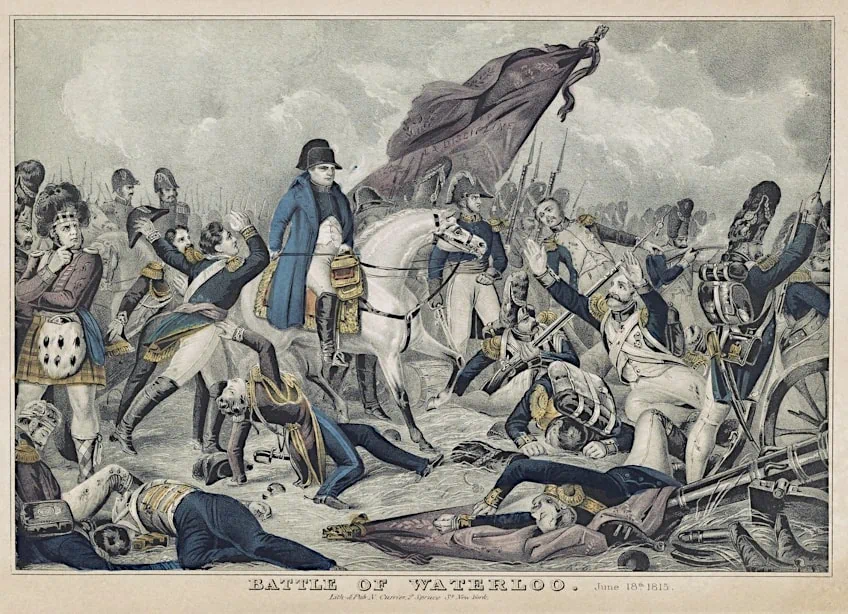 Battle of Waterloo printed by N. Currier (between 1835 and 1856); N. Currier (Firm), Public domain, via Wikimedia Commons
Battle of Waterloo printed by N. Currier (between 1835 and 1856); N. Currier (Firm), Public domain, via Wikimedia Commons
20th-Century Battles
The 20th century was defined by several conflicts and wars, many of which had far-reaching consequences for world history. Territorial disputes, ideological divisions, economic concerns, and nationalism were all factors in these battles.
World War I was one of the most major events of the 20th century, with the deployment of new technologies such as airplanes, tanks, and chemical weapons, and it led to the deaths of millions of people.
Another important conflict of the 20th century was World War II, which was later followed by the Cold War era.
Battle of Somme (1916) in Somme, France
| Battle Name | Battle of Somme |
| Date | 1916 |
| Combatants | British, French, and German armies |
| Location | Somme River, Pas-de-Calais, France |
This is regarded as one of history’s biggest and most important battles and was fought between the British-French armies and the German army during World War I.
The British-French armies launched the assault as part of a bigger offensive with the objective of breaking through German lines and ending the deadlock of trench warfare.
The first British assault was launched along a 30-kilometer front with the goal of taking the town of Bapaume which was held by the Germans. A massive artillery bombardment assisted the British troops, but the German defenders had built deep trenches and strengthened their defenses with barbed wire, making it impossible for the English troops to advance any further.
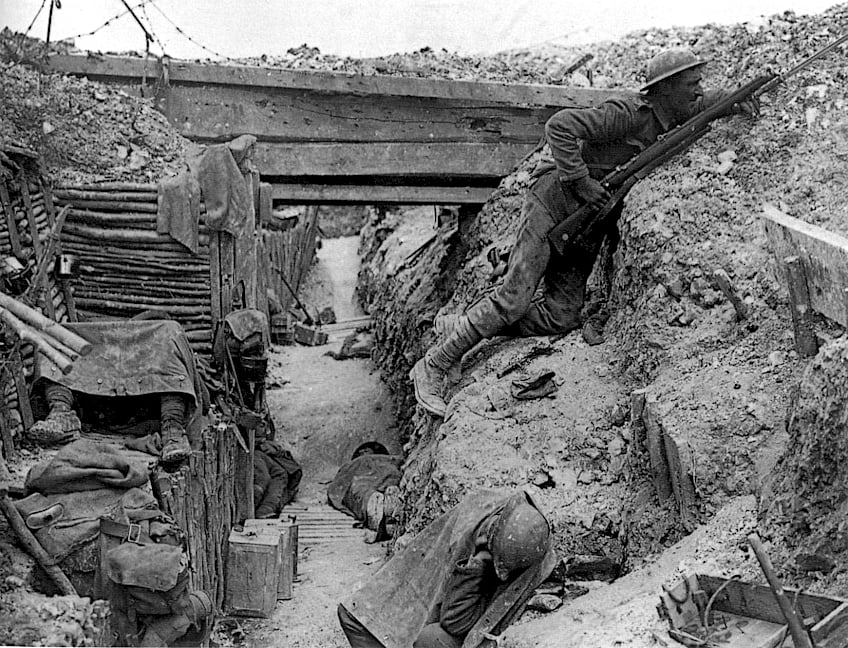 Trench warfare during the Battle of the Somme (July 1916); John Warwick Brooke, Public domain, via Wikimedia Commons
Trench warfare during the Battle of the Somme (July 1916); John Warwick Brooke, Public domain, via Wikimedia Commons
This famous battle featured the first employment of tanks in action, despite the fact that they were experimental and unreliable weaponry at the time.
The battle resulted in an inconclusive stalemate, with neither side of the conflict claiming a clear victory. It did, however, have a considerable impact on the trajectory of the war, forcing the Germans to shift men and supplies away from attacks on the Eastern Front.
Battle of Stalingrad (1942 – 1943) in Stalingrad, Soviet Union
| Battle Name | Battle of Stalingrad |
| Date | 1942 – 1943 |
| Combatants | Germans and Soviets |
| Location | Stalingrad, Soviet Union |
The Battle of Stalingrad is considered to be a very pivotal moment in World War II, fought between Soviet and German forces in the Russian city of Stalingrad. With over 1.2 million casualties, it is regarded as the biggest battle in history. In the summer of 1942, the German army started an operation to seize Stalingrad. The city was a vital transportation and industrial hub for the Soviet Union, and its seizure would have been devastating to the Soviet war effort.
The battle devolved into a deadly urban conflict, with German soldiers battling their way through the city’s debris and ruins, while the Soviet army fiercely guarded every road and building. The conflict featured close-quarters action, deadly hand-to-hand combat, and the usage of artillery, tanks, and aircraft.
 Red Army soldiers during the Battle of Stalingrad (1942); RakaAditya, CC BY-SA 4.0, via Wikimedia Commons
Red Army soldiers during the Battle of Stalingrad (1942); RakaAditya, CC BY-SA 4.0, via Wikimedia Commons
Despite huge losses on both sides of the battle, the Soviets eventually won, while the German troops suffered a devastating defeat. The battle demonstrated that the Germans were not unbeatable and gave the Allies confidence that they might eventually prevail over Germany. The largest battle in history was also considered a symbol of Soviet determination and perseverance in the face of massive challenges in the Soviet Union.
Battle of Midway (1942) in Midway Atoll, United States Minor Outlying Islands
| Battle Name | Battle of Midway |
| Date | 1942 |
| Combatants | Americans and Japanese |
| Location | Midway Atoll, United States Minor Outlying Islands |
The Battle of Midway was a naval conflict fought in World War II between the Americans and the Japanese. It happened in 1942, near the Midway Atoll, a small, isolated island chain located about halfway between Japan and Hawaii. It is considered a critical turning point in the war since it was the Japanese Navy’s first major loss and offered a much-needed confidence boost to the Allies.
Because of the surprising triumph of the American forces, this battle is sometimes called the “miracle at Midway.”
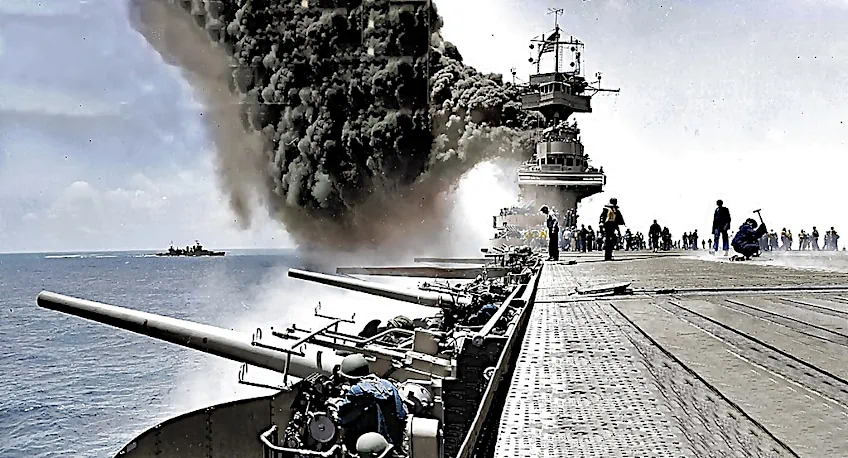 USS Yorktown during the Battle of Midway (1942); Cassowary Colorizations, CC BY 2.0, via Wikimedia Commons
USS Yorktown during the Battle of Midway (1942); Cassowary Colorizations, CC BY 2.0, via Wikimedia Commons
On the 4th of June, 1942, a fleet of aircraft carriers was dispatched to strike the Midway Atoll. The Americans, though, had tapped into Japanese communications and had been able to organize their own fleet to thwart the attack. On the 4th of June, the two fleets converged, and the American troops were able to cause substantial damage to the Japanese ships through a series of furious air battles. The majority of the Japanese carriers, as well as several other ships, were sunk.
On the 7th of June 7th, the Japanese launched one more last-ditch effort to strike the American carriers, but it was also thwarted and suffered heavy losses. The Japanese had no choice but to withdraw, and so the Battle of Midway ended.
Battle of Normandy (1944) in Normandy, France
| Battle Name | Battle of Normandy |
| Date | 1944 |
| Combatants | Allied forces and Germany |
| Location | Normandy, France |
The Battle of Normandy was a large military operation conducted by Allied forces, chiefly British, American, and Canadian forces, who landed on Normandy’s beaches in northern France. The operation’s purpose was to set up a base of operations in France and start liberating Europe from Nazi-controlled Germany. The operation started with a naval and aerial assault of German positions along the Normandy shoreline. The main attack consisted of landings by boats on five different beaches.
The landings proved extremely challenging and met with fierce opposition from the German forces. The beaches were heavily defended, and the German army had a variety of defensive barriers in place, such as mines, barbed wire, and anti-tank obstacles, that hindered the Allied landing forces.
 Newsmap from Monday June 12, 1944 showing the Normandy landings; United States GPO, Public domain, via Wikimedia Commons
Newsmap from Monday June 12, 1944 showing the Normandy landings; United States GPO, Public domain, via Wikimedia Commons
Despite these challenges, the Allied forces eventually gained a footing on the coastline and began marching inland. They received strong opposition from German soldiers but were eventually able to drive them back. As with many other famous battles on this list, it served as a vital turning point in the war, signaling the final chapter for Nazi Germany. The operation’s success enabled the Allies to start their western drive into Germany, whereas the Soviet Union pushed from the eastern side.
The Impact of Famous Battles
These famous battles have had an immense effect on human civilization and have helped shape the direction of our history. Battles waged for control of territory and political power have repeatedly occurred, and the consequences of these fights have had a significant impact on the structure of societies throughout time. For instance, the Norman Conquest of Britain and the emergence of a new ruling elite resulted after the Battle of Hastings in 1066.
Battles have also been waged over ideological and theological disputes, with their outcomes having a significant impact on cultural and societal standards.
For instance, the Ottoman Empire’s defeat in World War I resulted in the dissolution of the Islamic caliphate and the formation of secular administrations in many Muslim nations. Battles have also had a significant economic impact, as finite resources are redirected to assist military activities. Warfare has also resulted in changes in the economy, as communities have had to rebuild and heal from the devastation inflicted by war. In the aftermath of World War II an entire new world order emerged that gradually fostered a cold war between the Soviet Union and the democracies of the Western world.
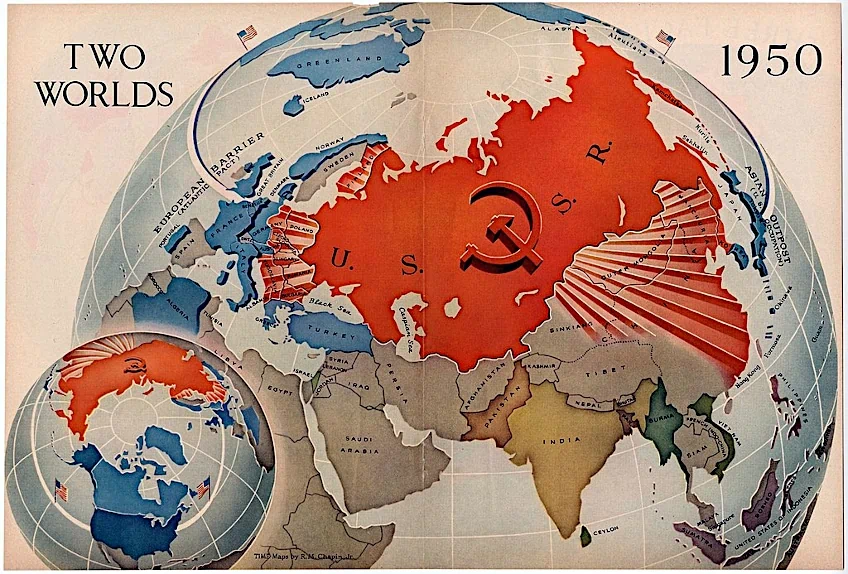 Illustration showing global political alliances during the Cold War by Robert M. Chapin (1950); Chapin, Robert M., Public domain, via Wikimedia Commons
Illustration showing global political alliances during the Cold War by Robert M. Chapin (1950); Chapin, Robert M., Public domain, via Wikimedia Commons
Impact on Technology
Throughout history, wars, and battles have significantly influenced technology, spurring advancements in a number of sectors. Throughout history, war has significantly influenced technology, spurring advancements in a number of sectors. More sophisticated weaponry has been developed as a result of wars as countries try to outwit their adversaries. As medical professionals and researchers try to create superior treatments for wounds and illnesses, battles often lead to advancements in medical technology.
As a result of the need to treat the many injured soldiers, for instance, World War I led to substantial advancements in the production of prosthetic limbs along with other breakthrough medical innovations.
 The artificial limb factory at Queen Mary’s Hospital in Roehampton 1941; Ministry of Information Photo Division Photographer, Public domain, via Wikimedia Commons
The artificial limb factory at Queen Mary’s Hospital in Roehampton 1941; Ministry of Information Photo Division Photographer, Public domain, via Wikimedia Commons
As the various militaries of the world attempt to maintain communication with personnel while coordinating operations, developments in communications technology have also accelerated. For instance, the invention of telegraph and radio technology in the second half of the 19th century and early 20th century was fueled in part by the need for improvements in wartime communication.
That wraps up our in-depth look at the famous battles that occurred throughout human history. Each of these famous battles, from those that suffered minimal casualties, to the largest battle in history, had a significant role in changing the course of history. While war and its affiliated battles are never pleasant, they are sometimes necessary in order for changes in tyrannical regimes to occur, and for empires to fall. Thankfully, though, these famous battles have also resulted in the acquisition of greater freedoms and liberties, as well as advances in technology, medicine, and communication.
Frequently Asked Questions
What Is Regarded As the Biggest Battle in History?
The largest battle in history is believed to be the Battle of Stalingrad (1942 – 1943) . Also regarded as one of the most important battles, it was fought between the Soviets and the Germans. Although the estimated number of casualties varied greatly, it is thought that around 1.2 million people lost their lives during the battle.
Why Are Most Important Battles Regarded As Significant?
Every war that occurs is usually the result of conflicting ideals and a desire for territory. Wars are often lengthy endeavors and are won through a series of battles for ground. Every battle will determine the outcome of the war, which will ultimately change the way the people existing during the war will live after it.

I am deeply passionate about history and am constantly fascinated by the rich and complex stories of the past. As the editor-in-chief of learning-history.com, I have the opportunity to share this passion with a wide audience through the creation and distribution of engaging and informative content about historical events, persons, and cultures. Whether it’s through writing articles and blog posts or creating videos or podcasts, I strive to bring the past to life in a way that is both accurate and enjoyable. My expertise in history, combined with my strong writing and communication skills, allows me to effectively communicate complex historical concepts and make them accessible and interesting to a wide range of readers. I am truly grateful for the opportunity to share my love of history with others through my work on learning-history.com.

